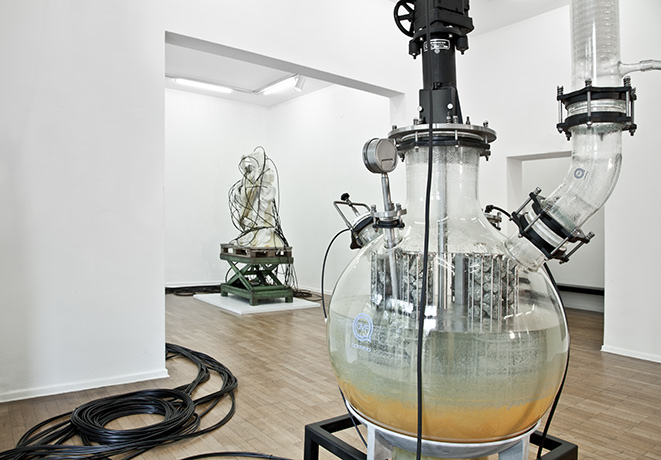
KASBEK, 2017
glass, steel, pyrite, chemolithoautotrophic bacteria (Acidithiobacillus ferrooxidans), plastic tubes, measurement and control technology, 260 x 100 x 75 cm
biotechnological realisation: Thomas Pümpel, Anna Arthofer, Christian Ebner, Department of Microbiology, University of Innsbruck
exhibition view PROMETHEUS DELIVERED, Haus am Lützowplatz, Berlin 2017
Chemolithoautotrophic bacteria (Acidithiobacillus ferrooxidans) feed on iron and sulphur (pyrite) in a bioreactor. Their metabolism produces sulphuric acid, which they release into the surrounding water. The acidic water flows through the tubing into the marble sculpture and its limestone is decomposed by the acid and transformed into gypsum. By reacting with the limestone, the pH-value of the water in the process is buffered and, after refluxing into the reactor, enables the continuous growth of microorganisms.
glass, steel, pyrite, chemolithoautotrophic bacteria (Acidithiobacillus ferrooxidans), plastic tubes, measurement and control technology, 260 x 100 x 75 cm
biotechnological realisation: Thomas Pümpel, Anna Arthofer, Christian Ebner, Department of Microbiology, University of Innsbruck
exhibition view PROMETHEUS DELIVERED, Haus am Lützowplatz, Berlin 2017
Chemolithoautotrophic bacteria (Acidithiobacillus ferrooxidans) feed on iron and sulphur (pyrite) in a bioreactor. Their metabolism produces sulphuric acid, which they release into the surrounding water. The acidic water flows through the tubing into the marble sculpture and its limestone is decomposed by the acid and transformed into gypsum. By reacting with the limestone, the pH-value of the water in the process is buffered and, after refluxing into the reactor, enables the continuous growth of microorganisms.